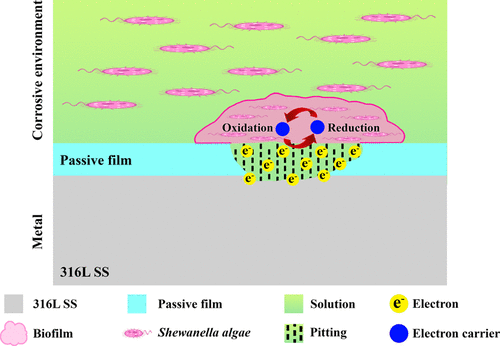当前位置:
X-MOL 学术
›
ACS Appl. Bio Mater.
›
论文详情
Our official English website, www.x-mol.net, welcomes your
feedback! (Note: you will need to create a separate account there.)
Accelerated Corrosion of 316L Stainless Steel Caused by Shewanella algae Biofilms
ACS Applied Bio Materials ( IF 4.6 ) Pub Date : 2020-03-24 , DOI: 10.1021/acsabm.0c00037 Phuri Kalnaowakul 1, 2 , Dake Xu 3 , Aphichart Rodchanarowan 1
ACS Applied Bio Materials ( IF 4.6 ) Pub Date : 2020-03-24 , DOI: 10.1021/acsabm.0c00037 Phuri Kalnaowakul 1, 2 , Dake Xu 3 , Aphichart Rodchanarowan 1
Affiliation

|
In the marine environment, microbiologically influenced corrosion (MIC) is a major problematic issue, which leads to severe damage to metals and alloys. The prerequisite to mitigate this worldwide problem is to investigate the mechanisms of marine-corroding microbes. Therefore, the corrosion behavior of 316L stainless steel in the presence of marine Shewanella algae was investigated by means of electrochemical measurements and surface analysis. The results revealed that S. algae is capable of forming a dense and thick biofilm on the surfaces of 316L SS coupons after 7 days of incubation, which reached about a thickness of 40.4 μm. According to electrochemical results, the S. algae biofilm also induced the corrosion of 316L SS coupons. The accelerated corrosion of 316L SS coupons was in the form of pits, which was formed underneath the biofilms. The largest pit depth after 14 days of incubation time reached 9.8 μm, which was 6.7 times higher than the one immersed in abiotic medium (1.45 μm). This is the first study demonstrating the MIC of 316L SS due to the S. algae biofilm.
中文翻译:

Shewanella藻类生物膜对316L不锈钢的加速腐蚀
在海洋环境中,微生物影响腐蚀 (MIC) 是一个主要问题,它会对金属和合金造成严重损害。缓解这一世界性问题的先决条件是研究海洋腐蚀微生物的机制。因此,通过电化学测量和表面分析,研究了 316L 不锈钢在海洋希瓦氏藻存在下的腐蚀行为。结果表明,S. algae能够在 316L SS 试样表面形成致密厚的生物膜,经过 7 天的培养,其厚度达到约 40.4 μm。根据电化学结果,S. algae生物膜也会引起 316L SS 试样的腐蚀。316L SS 试样的加速腐蚀呈凹坑形式,在生物膜下方形成。孵化14天后最大坑深达到9.8 μm,是非生物培养基(1.45 μm)的6.7倍。这是第一项证明 316L SS 的 MIC 由于S.藻类生物膜的研究。
更新日期:2020-04-23
中文翻译:

Shewanella藻类生物膜对316L不锈钢的加速腐蚀
在海洋环境中,微生物影响腐蚀 (MIC) 是一个主要问题,它会对金属和合金造成严重损害。缓解这一世界性问题的先决条件是研究海洋腐蚀微生物的机制。因此,通过电化学测量和表面分析,研究了 316L 不锈钢在海洋希瓦氏藻存在下的腐蚀行为。结果表明,S. algae能够在 316L SS 试样表面形成致密厚的生物膜,经过 7 天的培养,其厚度达到约 40.4 μm。根据电化学结果,S. algae生物膜也会引起 316L SS 试样的腐蚀。316L SS 试样的加速腐蚀呈凹坑形式,在生物膜下方形成。孵化14天后最大坑深达到9.8 μm,是非生物培养基(1.45 μm)的6.7倍。这是第一项证明 316L SS 的 MIC 由于S.藻类生物膜的研究。











































 京公网安备 11010802027423号
京公网安备 11010802027423号